Chemistry:Chlorophyll c
Chlorophyll c refers to forms of chlorophyll found in certain marine algae, including the photosynthetic Chromista (e.g. diatoms and brown algae) and dinoflagellates.[1][2][3] These pigments are characterized by their unusual chemical structure, with a porphyrin as opposed to the chlorin (which has a reduced ring D) as the core; they also do not have an isoprenoid tail. Both these features stand out from the other chlorophylls commonly found in algae and plants.[2]
It has a blue-green color and is an accessory pigment, particularly significant in its absorption of light in the 447–52 nm wavelength region.[3] Like chlorophyll a and chlorophyll b, it helps the organism gather light and passes a quanta of excitation energy through the light harvesting antennae to the photosynthetic reaction centre.[2]
Chlorophyll c can be further divided into chlorophyll c1, chlorophyll c2,[3] and chlorophyll c3,[4] plus at least eight other more recently found subtypes.[5]
Chlorophyll c1
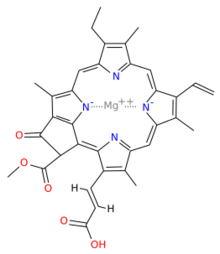
| |
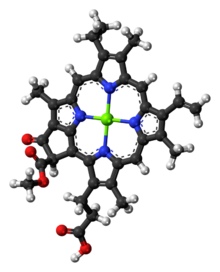
| |
| Names | |
|---|---|
| IUPAC name
[(2E)-3-[14-Ethyl-21-(methoxycarbonyl)-4,8,13,18-tetramethyl-20-oxo-9-vinyl-3,4-didehydro-3-phorbinyl-κ2N23,N25]acrylato(2-)]magnesium
| |
| Identifiers | |
| |
3D model (JSmol)
|
|
| 5801077, 6996880 | |
| ChEBI | |
| ChemSpider | |
PubChem CID
|
|
| UNII |
|
| |
| |
| Properties | |
| C35H30MgN4O5 | |
| Molar mass | 610.953 g·mol−1 |
Except where otherwise noted, data are given for materials in their standard state (at 25 °C [77 °F], 100 kPa). | |
| Infobox references | |
Chlorophyll c1 is a common form of chlorophyll c. It differs from chlorophyll c2 in its C8 group, having an ethyl group instead of vinyl group (C-C single bond instead of C=C double bond). Its absorption maxima are around 444, 577, 626 nm and 447, 579, 629 nm in diethyl ether and acetone respectively.[6]
Chlorophyll c2
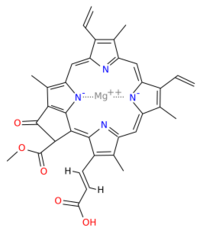
| |
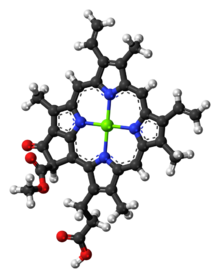
| |
| Names | |
|---|---|
| IUPAC name
[(2E)-3-[21-(Methoxycarbonyl)-4,8,13,18-tetramethyl-20-oxo-9,14-divinyl-3,4-didehydro-3-phorbinyl-κ2N23,N25]acrylato(2-)]magnesium
| |
| Identifiers | |
3D model (JSmol)
|
|
| 5801049 6996841 | |
| ChEBI | |
| ChemSpider | |
PubChem CID
|
|
| UNII | |
| |
| |
| Properties | |
| C35H28MgN4O5 | |
| Molar mass | 608.937 g·mol−1 |
Except where otherwise noted, data are given for materials in their standard state (at 25 °C [77 °F], 100 kPa). | |
| Infobox references | |
Chlorophyll c2 is the most common form of chlorophyll c.[7] Its absorption maxima are around 447, 580, 627 nm and 450, 581, 629 nm in diethyl ether and acetone respectively.[6]
Chlorophyll c3
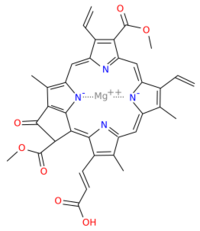
| |
| Identifiers | |
|---|---|
3D model (JSmol)
|
|
PubChem CID
|
|
| UNII | |
| |
| |
| Properties | |
| C36H28MgN4O7 | |
| Molar mass | 652.946 g·mol−1 |
Except where otherwise noted, data are given for materials in their standard state (at 25 °C [77 °F], 100 kPa). | |
| Infobox references | |
Chlorophyll c3 is a form of chlorophyll c found in microalga Emiliania huxleyi, identified in 1989.[4] Its absorption maxima are around 452, 585, 625 nm and 452, 585, 627 nm in diethyl ether and acetone respectively.[6]
Biosynthesis
Chlorophyll c synthesis branches off early from the typical Chlorophyllide synthesis pathway, after divinylprotochlorophyllide (DV-PChlide) is formed. DV-PChlide can be processed directly by an unidentified 171 oxidase into Chl c2. An 8-vinyl reductase (elaborating on the promiscous behavior of ferredoxin-type 3,8-divinyl chlorophyllide reductase) could then convert Chl c2 into Chl c1. The two steps could be swapped for the same effect.[8]
The 171 oxidtion appears to proceed by "hydroxylation of the 17-propionate reside at the 171-position and successive dehydration to the 17-acrylate residue."[9]
References
- ↑ Speer, B. R.. "Photosynthetic Pigments". http://www.ucmp.berkeley.edu/glossary/gloss3/pigments.html.
- ↑ 2.0 2.1 2.2 Blankenship, Robert E. (February 2002). Molecular Mechanisms of Photosynthesis. Wiley-Blackwell.
- ↑ 3.0 3.1 3.2 "The structure, properties, and distribution of chlorophyll c". Journal of the American Chemical Society 92 (9): 2826–33. May 1970. doi:10.1021/ja00712a037. PMID 5439971.
- ↑ 4.0 4.1 "The structure of chlorophyll c3, a novel marine photosynthetic pigment". J. Chem. Soc., Chem. Commun. (23): 1827–28. 1989. doi:10.1039/C39890001827.
- ↑ Zapata, Manuel; Garrido, José L.; Jeffrey, Shirley W. (2006). "Chlorophyll c Pigments: Current Status". Chlorophylls and Bacteriochlorophylls: Advances in Photosynthesis and Respiration. Advances in Photosynthesis and Respiration 25: 39–53. doi:10.1007/1-4020-4516-6_3. ISBN 978-1-4020-4515-8.
- ↑ 6.0 6.1 6.2 "A new form of chlorophyll C involved in light-harvesting". Plant Physiology 91 (2): 727–32. October 1989. doi:10.1104/pp.91.2.727. PMID 16667093.
- ↑ "The Occurrence of Chlorophyll c1 and c2 in Algae". Journal of Phycology 12 (3): 349–354. September 1976. doi:10.1111/j.1529-8817.1976.tb02855.x.
- ↑ Ito, Hisashi; Tanaka, Ayumi (March 2014). "Evolution of a New Chlorophyll Metabolic Pathway Driven by the Dynamic Changes in Enzyme Promiscuous Activity". Plant and Cell Physiology 55 (3): 593–603. doi:10.1093/pcp/pct203. PMID 24399236.
- ↑ Xu, M; Kinoshita, Y; Matsubara, S; Tamiaki, H (March 2016). "Synthesis of chlorophyll-c derivatives by modifying natural chlorophyll-a.". Photosynthesis Research 127 (3): 335–45. doi:10.1007/s11120-015-0190-1. PMID 26346903.

